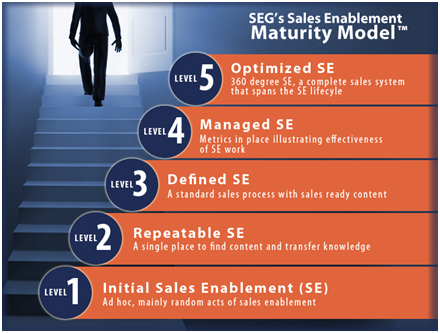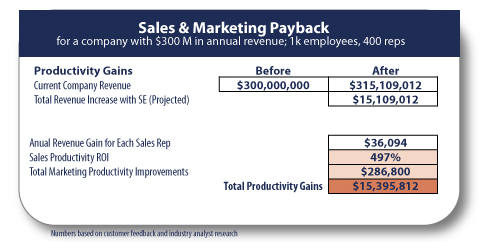By Craig Nelson, Founder and Principal, Sales Enablement Group
Over the years I’ve had an opportunity to work with companies that felt that sales enablement (SE) was at the core of advancing deals, ramping new reps, launching new products and, in the end, growing their sales channels to drive profitable revenue. I’ve been fortunate to have been part of more than 100 sales enablement deployments and can say first hand that when done right, SE quickly becomes a true asset to the organization with both short and long term payback. We’ll get to the payback later.
By Craig Nelson, Founder and Principal, Sales Enablement Group
Over the years I’ve had an opportunity to work with companies that felt that sales enablement (SE) was at the core of advancing deals, ramping new reps, launching new products and, in the end, growing their sales channels to drive profitable revenue. I’ve been fortunate to have been part of more than 100 sales enablement deployments and can say first hand that when done right, SE quickly becomes a true asset to the organization with both short and long term payback. We’ll get to the payback later.
In terms of SE’s definition, a word of caution, don’t spend too much time debating its meaning. It will evolve over time as your organization moves up the SE maturity model (shown below) and regardless of how SE is defined I suggest that the focus be on the desired outcome. For example:
With an effective marketing and sales enablement system in place, enablement roles that span departments are aligned to ensure better conversations both internally (PM, marketing, sales and training) and externally between sellers and buyers. The lasting value of SE starts with more effective sellers that client’s need, and more targeted and informed customers that provide an increase in customer life-time-value, critical in what has become a service oriented world.
Also, it’s important to go beyond a conceptual definition to better understand SE in practice:
- SE Concept: Drive knowledge transfer to improve sales effectiveness and efficiency.
- SE Scope: A system that enables all sales channels; from day one of a new hire or partner relationship, to closing new business in a repeatable fashion.
- SE in Practice: SE is delivered through a marketing and SE system used to transfer knowledge on-demand. An example use case for knowledge transfer is to make content easy to find, adapt, deliver and track before, during and after a sales call. Further is the support for collaboration when using the knowledge with access anywhere and anytime to fully leverage the power of the organization.
Marketing And Sales Enablement System Components
In practice there are five SE components needed to fully realize the benefits of SE:
- Process
- Tools
- Enablement Roles
- Content
- Best Practice & Resources
To better understand the SE components the following diagram provides examples of each one mapped to the process required to enable effective sales staff and partners:

Note: The processes, tools, enablement roles, content and best practices listed are examples and vary by organization.
Sales Enablement Today
A survey at a recent marketing and sales conference hosted by SiriusDecisions ranked sales enablement as the No. 1 requirement. From what I recall this is the first time that enablement was seen as more important than demand creation and solution marketing, which ranked No. 2 and No. 3, respectively. Further review of the top inhibitors of sales effectiveness was the inability to communicate the value message and the need to obtain subject matter expertise of the industry or solution. As the saying goes, knowledge is power, especially in today’s selling environment.
It’s exciting to see the number of SE product and service vendors with offerings that are based on deep SE domain expertise; this wasn’t the case even five years ago. Vendors can provide everything from creating more compelling content to SE tools covering the entire SE lifecycle . And with the increase in support for mobile devices, SE delivers value during client conversations which happens many times every hour of every day. For many they refer to their marketing and sales enablement system as the “single source of truth” or they brand it as something meaningful to their organization and staff.
Why Isn’t Everyone Already Doing SE?
I would argue that many already have some degree of SE in place today, especially B2B firms that have good organizational alignment already in place. Although SE may not have been a headliner in terms of market awareness in the past, many companies have been quietly leveraging what has become a competitive advantage; a complete marketing and sales enablement system. In this case they may inherently have SE processes in place for example, ramping new reps, content workflow, launching new product, and so forth. However improvement is possible with additional structure and it doesn’t require new departments. Many organizations already have resources, however due to lack of SE maturity they most likely act independently and produce what Forrester Research calls “random acts of sales enablement.” These organizations would benefit from formal SE processes, disciplines and the alignment SE promotes. It’s true that the definition of SE is evolving and the SE tool market remains fragmented, but there are highly qualified vendors that can help support the SE components.
Getting The Most From SE
For those that lead SE initiatives today there is good news, SE is a “pull” type initiative which is why it’s the No. 1 sales requirement. Information overload is a huge issue and only getting worse. The downside of not having SE be effective? Go on a few sales call to quickly learn firsthand how a sales rep prepares, what material is delivered and what messaging is used with the prospect. There are many anecdotes I could share here, but this is a classic: I recall stopping at a copy shop on the way to a sales call and waiting as the sales rep printed his version of the company’s marketing materials. Obviously not a good thing for anyone, including the customer.
Now, to get the most of SE requires an understanding of organizational change. A recent Forrester SE conference covered the impact of organizational drag on SE. At this conference there were many fantastic customer stories on how SE had become a true asset and one thing in common across the companies was strong leadership and the need to address the impact of change. With SE we have learned there are three key challenges to address organizational change and mitigate organizational drag:
- Cross-functional ownership and commitment;
- Awareness of the right content and tools; and
- Ongoing commitment to adding value to the seller & customer (not auditing them).
Each of these challenges can be addressed by the SE maturity model.
Getting Started With A Practical Approach: SE Maturity Model
The process to deploy and manage SE can be mapped to what we call the SE Maturity Model. The model lays the foundation with milestones to effectively move forward with SE regardless of the current level of SE maturity. The following graphic provides an overview of the steps and their focus:

The steps can be done in sequence or in some cases in parallel, based on the maturity of the organization. What we have learned is that as an organization moves up a level in SE maturity their payback increases, thus providing ongoing incentive to evolve and improve SE.
Justifing SE Payback
The discussion wouldn’t be complete without taking into consideration the financial payback. When an SE plan is well executed it impacts the bottom line in two ways:
- Increase: deal size, win rate, number of opportunities worked, quota attainment
- Decrease: ramp time, sales cycle length, print costs, unused content, cost of sale
Note: the payback numbers are based on customer and industry feedback gathered over the past 10 years and spans many different types of B2B companies.
In a future Demanding Views article, I will continue on the topic of SE with a focus on mapping out the Sales Enablement Lifecycle from a process and tools perspective.
Craig Nelson is Founder and Principal of Sales Enablement Group. He can be reached at [email protected].







